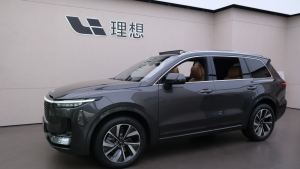Among the stocks that underperformed the worst in 2021 were Chinese growth stocks. Indeed, a range of headwinds materialized that saw some of 2020’s best-performing stocks head right back down to earth. That’s perhaps putting the selloff mildly.
Starting at the end of 2020, Chinese regulators saw fit to put their foot down, hard, on the throats of many Chinese tech stocks. Companies saw crackdowns on monopolistic practices, massive fines, forced de-listings, removal off apps from app stores, the regulating out of entire sectors and more. Indeed, for many Chinese growth stocks, last year was a year to forget.
Here’s the good news: We’re now in 2022. You know, new year, new you. For Chinese growth stocks, investors certainly may hope this is the case.
China’s economy has for some time been the envy of Western nations. Indeed, China’s GDP growth rate has dwarfed the U.S. and most developed nations for decades. However, recent data suggests China’s incredible GDP growth trajectory may be slowing, furthering the negative narrative around these stocks via the heightened regulatory environment in China.
That said, there are a number of reasons why investors may want to pay attention to Chinese growth stocks. China’s a massive economy that’s still developing. The country’s middle class is massive and growing. And despite slower population growth than the CCP would like to see, it’s still growing faster than most of the developed world.
For those willing to take a bullish stance on China, here are seven top stocks to keep an eye on right now:
- JD.com (NASDAQ:JD)
- Dingdong (NYSE:DDL)
- PetroChina (NYSE:PTR)
- Alibaba (NYSE:BABA)
- Xpeng (NYSE:XPEV)
- Li Auto (NASDAQ:LI)
- BYD (OTCMKTS:BYDDF)
Top Chinese Growth Stocks: JD.com (JD)

One of the top e-commerce stocks in China is JD.com. This stock is one that has generally outperformed its peers, even through this period of market uncertainty last year. A company with a business model that resembles Amazon in many ways, JD.com is an e-commerce giant in China. This company sells a wide array of products, from clothes to electronics.
JD stock has been on a rough go of late. This stock touched an all-time high of more than $108 per share approximately one year ago. Since then, shares have sunk more than 30% as investors price in the aforementioned regulatory headwinds into this stock.
Unlike a few of its peers, JD has actually come through this regulatory environment relatively unscathed. However, it’s the fact that this is a China-based company that has investors concerned. The degree to which investor capital is safe in China is of key concern to investors.
Despite the government’s restrictions on the internet, JD.com revenue rose 32% to $33.9 billion in its latest quarter. With an operating cash flow of $6.4 billion, this company can easily fulfill its plans to expand in 2022.
JD.com has plans to revamp its online and offline strategy to overtake Alibaba as the industry leader. The company has suggested an expansion project to enter into fast-growing market of pharmacies, electronics and appliances. Accordingly, this is a stock many long-term investors have on their radar as a key Chinese growth stock to own.
Dingdong (DDL)

One of the more recent Chinese IPOs to take the market by storm, DingDong listed on the NYSE in mid-2021. After surging to $46 per share on its debut, shares of this e-commerce company have since dwindled to around $5 per share. That’s good for a loss of nearly 90% from its peak.
For any company, that’s one heck of a loss. For an e-commerce player in China, this discount may be too good to ignore.
Dingdong can be viewed in some ways as the “Uber Eats” of China. This company provides daily essentials and fresh food to clients all over China. The company targets a 29-minute delivery time. It renders its services in 29 cities and caters to a monthly user base of 6.9 million customers.
Even though DDL stock has underperformed since its listing, this company is fortunately gaining a leadership position in the grocery market. The Chinese daily necessity market is estimated to grow at an annual rate of 7% through 2025. This could make Dingdong the leader of a market worth $2.4 trillion.
The financials and the targets of this company indicate an uphill climb in DDL’s share prices. According to its latest quarterly report, revenue rose 111% year-over-year. Furthermore, gross and net margins look promising for 2022.
Analysts are bullish about the future prospects of DDL. They have estimated an earnings growth rate of 50.7% for 2022 and 46% for the next five years.
Top Chinese Growth Stocks: PetroChina (PTR)

The profits of China’s largest integrated oil firm increased fivefold in 2021. Despite being a state-run firm, making it vulnerable to the government’s actions, PetroChina did not stumble with China’s other stocks. Instead, it went ahead to become a leader in the oil-energy sector.
Share prices of PTR floated impressively in 2021 and are currently valued at a bit below $50. However, PTR stock is currently trading 7x less than its trailing earnings. Considering the ever-growing demand for natural gas and PetroChina’s above-average performance, this stock is highly undervalued.
So far in 2022, stocks in the oil-energy sector gained an average of 10.7%, whereas PTR gained 12.2%. In its third quarter, the company’s revenue rose 37.5%, reaching 683.8 billion RMB ($108 billion).
Given its outstanding performance, analysts have predicted a 429% YoY increase in earnings-per-share for FY 2021.
PetroChina’s strong financials and involvement in various sectors of the Chinese economy make this company extremely crucial to the country’s development. As a result, massive upside potential exists for this company in the coming years.
Alibaba (BABA)

Alibaba was among the hardest-hit Chinese tech stocks last year. Generally considered to be the catalyst for this tech-related crackdown, Alibaba’s monopolistic practices were the focal point of regulators for much of last year. The company was slapped with a $2.8 billion fine, and its Ant Group IPO was shelved. Founder Jack Ma was forced to step aside, and a whole wave of uncertainty ensued.
However, for those looking at the bigger picture, most of these regulatory headwinds are behind Alibaba. Often called the “Amazon of China,” Alibaba’s e-commerce footprint in China and in many southeast Asian countries is impressive.
After falling 52% in one year, the investors and shareholders of BABA can now breathe a sigh of relief. So far in 2022, this stock has mostly risen, reaching a peak of $138.70. It has retracted slightly from this peak but is still ahead of its December low.
Despite a disappointing year, Wall Street remains bullish about the long-term fundamentals of Alibaba. As China follows a stringent lockdown policy, new Covid-19 variants like omicron are a boon for this company’s earnings and sales.
Furthermore, to rebuild the trust of shareholders and boost growth in 2022, Alibaba has announced various structural changes.
The company is set to open a domestic and international commerce unit. The latter, under Ali Express, will focus on markets in Europe and South America.
Alibaba has a legacy that it continues to maintain. Despite tumbling prices, the revenue of this company has grown at a compound annual growth rate of 42% since 2018. This leads to a very bullish long-term outlook for this stock.
Top Chinese Growth Stocks: Xpeng (XPEV)

China is home to the world’s largest and fastest-growing electric vehicle market. However, this market is highly competitive. Xpeng Motors, BYD, Li Auto and Nio fight hard in the title race to become the industry leader.
According to analysts, given the potential of XPEV, it is an aggressive buy. The company has three models: the G3 SUV, the P7 sports sedan and a smaller P5 family sedan.
In December 2021 alone, Xpeng sold 16,000 EVs, which was a 181% YoY increase. On top of that, deliveries for the whole year rose 263% as it sold 98,155 EVs in 2021.
XPEV did stumble in the latter half of 2021, reaching a low just below $34. So far in 2022, XPEV stock is down 23%.
In 2022, Xpeng will expand its model portfolio. In Q3 of 2022, its new model G9 SUV will come into the market. Furthermore, this company will soon make an entrance into the second-largest EV market. It already sells G3 SUVs in Norway, but now has plans to expand to Sweden, the Netherlands and Denmark. It will hopefully boost sales and make the share prices reach an all-time high.
Li Auto (LI)

Another EV maker making headlines would be the newly listed Li Auto. In August 2021, Li Auto raised $1.1 billion in its initial public offering. Since then, its journey has been far from disappointing.
Despite a worldwide chip shortage and regulatory concerns, the robust financials of this company suggest a significant upside potential in 2022. Li Auto’s earnings are dependent on its first model, Li One, which was released in May 2021.
In Q4 of 2021, Li Auto delivered 35,221 EVs, representing a 143% year-over-year surge. In December alone, 14,087 Li Ones were sold. According to the detailed third-quarter report, revenue rose a massive 209.7% year-over-year, reaching $1.23 billion for the quarter.
To overtake its competitors in 2022, Li Auto is expanding its manufacturing capacity. The EV maker has 206 retail stores in 102 cities and has started building a manufacturing plant in Beijing. It also acquired a 100% equity interest in Changzhou Chehejin Standard Factory, which will further boost its sale in 2022.
At its Jan. 24 opening value of $26.70, Wall Street analysts believe that LI has a 92% upside potential.
Top Chinese Growth Stocks: BYD (BYDDF)

In the competitive Chinese EV market, if one EV maker had the highest probability of becoming the industry leader, it would be BYD. The company makes electric cars and buses, and compared to its competitors, BYD is far ahead in sales and profitability.
BYD Co. started manufacturing automobiles in 2002, and now 53% of its revenue comes from that segment. This company has shifted its manufacturing focus from engine vehicles to electric vehicles in recent years. It sells four EV models: the Han, Tang SUV, Yuan, Song Pro and Quin Pro.
BYD’s automobile deliveries jumped 218% year-over-year to 92,823 in December of 2021. The sales numbers are way above those of any other Chinese EV maker, like Li Auto, Nio and Xpeng. Furthermore, including EV and hybrid sales, BYD goes ahead to even beat Tesla’s China sales.
For the past two years, this company’s average revenue has grown at an annualized rate of 30%. To top it off, considering its outperformance, BYD’s stock trades at a far more valuable price ($31.14 at the start of Jan. 24) than its competitors.
BYDDF’s listing in Hong Kong indeed means that the stock is prone to major dips, ups and downs and corrections. But fortunately, this saves BYD from the fear of being delisted from the USA’s stock market.
On the date of publication, Chris MacDonald did not have (either directly or indirectly) any positions in the securities mentioned in this article. The opinions expressed in this article are those of the writer, subject to the InvestorPlace.com Publishing Guidelines.
Chris MacDonald’s love for investing led him to pursue an MBA in Finance and take on a number of management roles in corporate finance and venture capital over the past 15 years. His experience as a financial analyst in the past, coupled with his fervor for finding undervalued growth opportunities, contribute to his conservative, long-term investing perspective.
